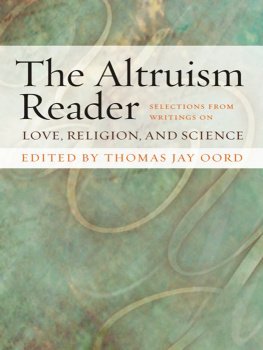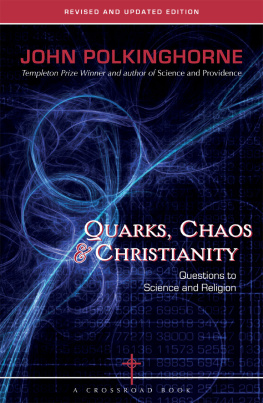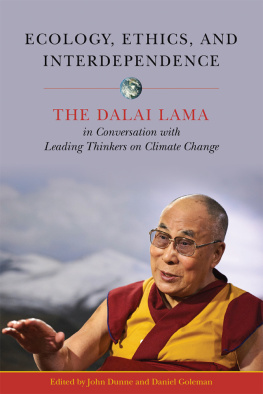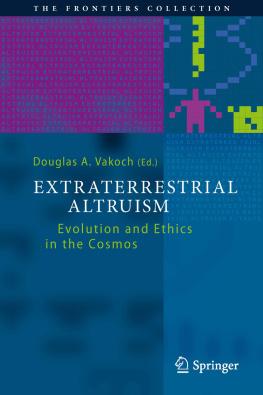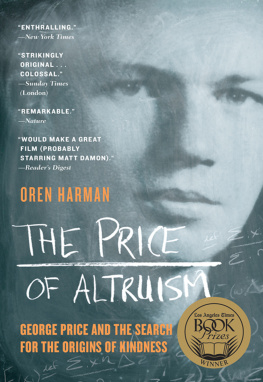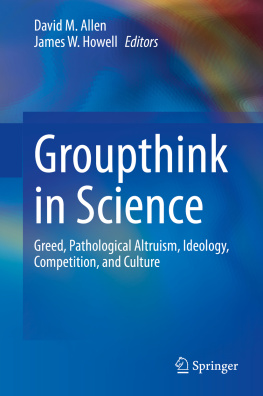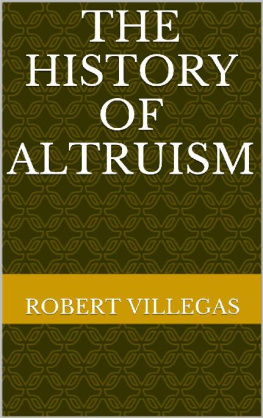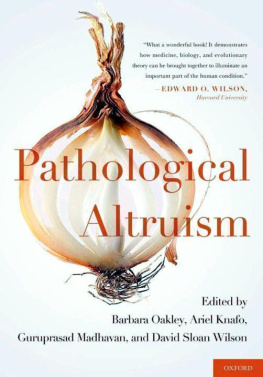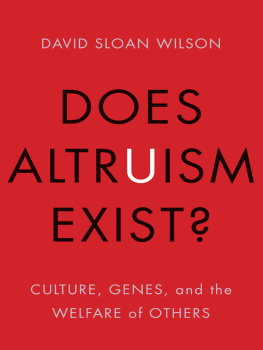The Altruism Reader
SELECTIONS FROM WRITINGS ON
LOVE, RELIGION, AND SCIENCE

Compiled and Edited by
Thomas Jay Oord
T EMPLETON P RESS
Templeton Press
300 Conshohocken State Road, Suite 550
West Conshohocken, PA 19428
www.templetonpress.org
2008 by Thomas Jay Oord
All rights reserved. No part of this book may be used or reproduced, stored in a retrieval system, or transmitted in any form or by any means, electronic, mechanical, photocopying, recording, or otherwise, without the written permission of Templeton Foundation Press.
Publishers Note: The Altruism Reader is an anthology of previously published works. Therefore, we have made only minor modifications to the text in this book. In certain chapters, it may be necessary to refer to the original source for complete references.
Library of Congress Cataloging-in-Publication Data
The altruism reader : selections from writings on love, religion, and science / edited by Thomas Jay Oord.
p. cm.
Includes bibliographical references (p.).
ISBN-13: 978-1-59947-127-3 (pbk. : alk. paper)
ISBN-10: 1-59947-127-2 (pbk. : alk. paper) 1. Altruism. 2. Charity. 3. LoveReligious aspects. I. Oord, Thomas Jay.
ISBN: 978-1-59947-221-8 (ebook)
BJ1474.A4725 2007
155.232dc22
2007027975
Designed and typeset by Gopa & Ted2, Inc.
Printed in the United States of America
07 08 09 10 11 12 10 9 8 7 6 5 4 3 2 1
Contents

Preface

T HE WORD LOVE may be the most important and yet most ambiguous word in the English language. We speak about loving food, falling in love, loving God, feeling loved, and loving a type of music. We say love hurts, love stinks, love means never having to say were sorry, love waits, love is the answer, and God is love.
The ambiguity of love meanings prompted psychologist Sigmund Freud to note that love is employed in language in an undifferentiated way.
This ambiguity encourages us to search for other words to clarify what we mean by love. The word altruism is one such substitute, and it occupies a prominent place in the sciences. The word literally refers to the other. Many people refer to actions aimed at the best interest of others as other-regard. Such actions are altruistic.
Scientists, theologians, and philosophers employ still other words to refer to love and altruism. Some prefer words like compassion, agape, prosocial behavior, care, positive regard, and benevolence. These words carry connotations with particular importance for those who use them, and complex debates can emerge about which words best describe the phenomenon in question.
Off and on over the centuries, scholars have pondered the questions of altruism and love. Sometimes this research takes the form of answering the big question: How do we best understand love? This question is basically one of theory, but it typically leans heavily upon experienceboth observed in others and felt personally. The theoretical question generates considerable and sustained reflection.
Scholars of religion have often assumed that promoting loving behavior is finally more important than a theoretical description of what love is. They have focused more upon promoting loving behaviors and delineating what it takes to form loving people. But this emphasis upon promoting love inevitably leads to discerning which acts or feelings are loving and which are not. And such discerning relies at least somewhat on theory and definition.
The sciences have typically spent more energy asking for evidence of love. This effort tends to focus upon studying consequences and motives. Discerning motives is difficult, but some researchers devise methods to overcome this difficulty. More often, scientists measure the consequences of actions. From these quantifiable consequences, they propose possible scientific explanations. Still other scientiststypically those in the social sciencesidentify different kinds of love, or they distinguish between love and other actions and emotions. All of these typically scientific endeavors, however, possess important points of contact with religious concerns about love.
Research on love has become more common in recent decades. This shift is due in part to developments in the sciences. Scientific positivists in the early twentieth century dismissed value-laded claims about existence because it is difficult to verify such claims with our five senses. In the late twentieth and early twenty-first centuries, however, scientists have become aware that questions of value are not only important as research programs but even reside at the core of science itself.
Although scientific research on altruism and love is enjoying a surge in recent days, it has actually been around in some form for millennia. Early in human evolutionary history, humans wanted evidence to establish the claim that one person loves another in the sense of acting for anothers best interest. In this sense, contemporary scientific research continues the age-old quest to understand better what most humans consider an extremelyif not the mostimportant aspect of life.
Research on love in religious studies is also becoming more prevalent in recent years. This interest is fueled in part by the attempt to overcome interreligious conflict. Some see religious research on love as a means to find commonalities among the worlds great religions. Still others wonder if theologies of love are more intellectually and existentially viable than theologies oriented around other ultimate concerns.
Religions that consider love as a key if not the primary divine attribute are especially interested in love studies. Often, theologies of love emerge as theologians work with revelation, traditions, reason, and personal experience to formulate an intellectually and existentially viable understanding of God. This endeavor seems especially important to those theological traditions that contend that humans were made in the image of God and are called to imitate God in at least some ways.
As the title suggests, this book offers various essays on love and altruism. The first half provides material from religious traditions, important theologians, and moral philosophers. Included are primary texts from sacred books and classic sources. Much of the first section also includes contemporary reflections on love and altruism. This material derives from some of the leading love scholars of our time. Of course, this selection is just the tip of the iceberg; many more essays on love and altruism worthy of inclusion in this anthology are not present because of space constraints.
The second half of the book includes material describing scientific research on love. Most of this research has been in the social and biological sciences. Research summaries and theories in psychology, sociology, anthropology, neurology, sociobiology, and nonhuman primate studies are included. In these contexts, love is often identified with altruism. Here, too, these essays represent a small portion of the large body of scientific research related to love and altruism.
The essays in this collection are reprinted as they were first published. However, because some are excerpts from longer chapters or were originally chapters in a full-length work, minor discrepancies will appear, such as references to previous pages or statements in the original work. A reference for the original publication is provided for each essay, so that the reader may go to the original, if necessary.

